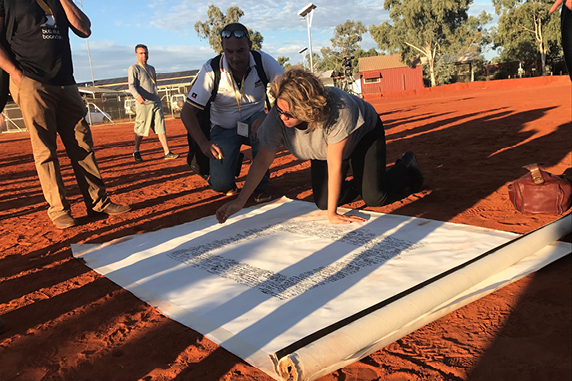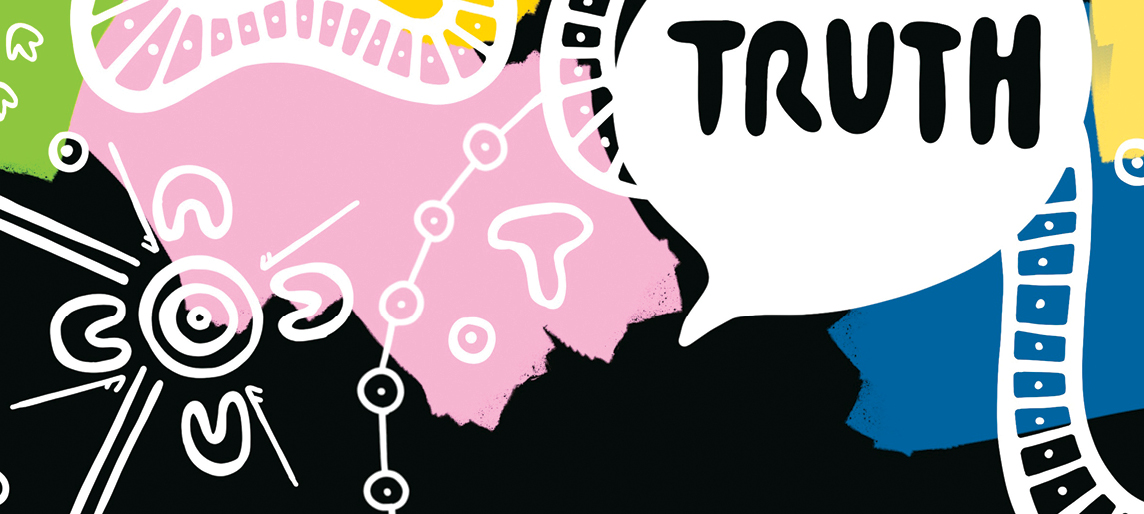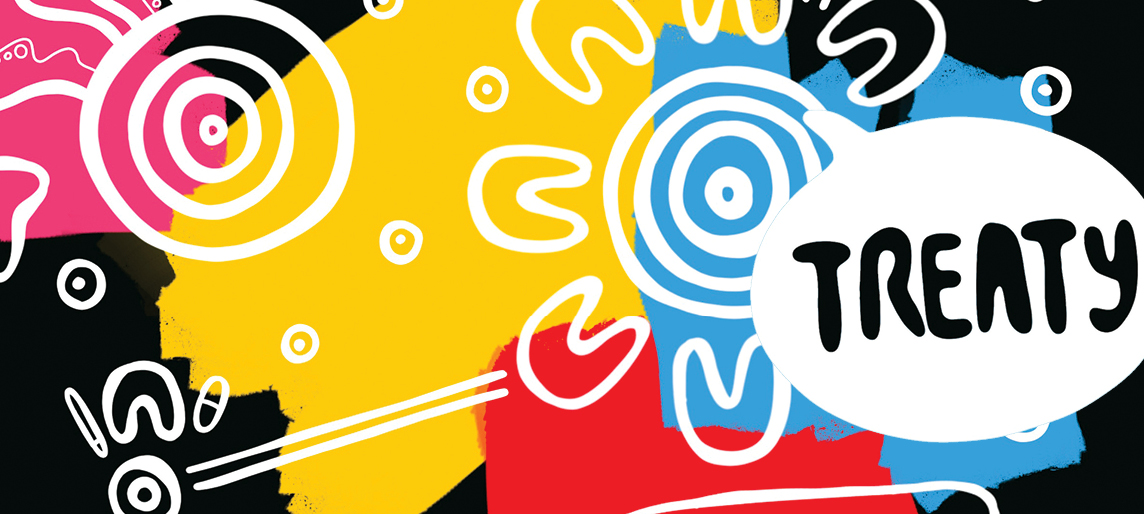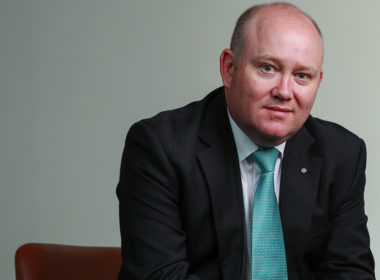In 2017, the Uluru Statement from the Heart urged non-Indigenous Australians “to walk with” Indigenous Australians for Voice, Treaty and Truth. Four years on from the historic convention, LSJ explores how penning such recognition in the Constitution could shape the destiny for Indigenous children and be a true marker of reconciliation.
Featured artwork
Girrili means ‘to make noise’ in Gudanji (my Traditional language) I created this piece while listening to the Uluru Statement from the Heart. I felt that while the statement was an amazing moment, there is still so much going on that needs to be heard and needs help. This piece shows family groups coming far and wide to sit and discuss.
Artist Ryhia Dank – Gudanji/Wakaja

We, gathered at the 2017 National Constitutional Convention, coming from all points of the southern sky, make this statement from the heart:
In the soil of Uluru was etched a roadmap to righting the wrongs of history: a path for non-Indigenous Australians to walk alongside Indigenous Australians towards a new future. A dream that every Indigenous child can flourish from birth; no longer at greater risk of being removed from their families, of being jailed, of dying decades earlier than non-Indigenous people. A say in shaping their own destiny.
On 26 May 2017, the Uluru Statement from the Heart was drafted at the National Constitutional Convention. The Statement calls for a First Nations Voice enshrined in the Australian constitution, by way of referendum, and a Marrakatta (Yolngu word describing “a process of conflict resolution, peacemaking and justice”) Commission to facilitate the process of agreement-making and truth-telling between the Federal Government and Aboriginal and Torres Strait Islander Peoples.
In enshrining a Voice to Parliament by way of an enabling provision, it would ensure that Indigenous Australians have a say on issues that directly affect their communities. Such a change would bring Australia into line with other countries that have a First Nations Parliament, including Norway and Sweden.
“The Uluru Statement was the culmination of a dialogue process designed to take agreement and disagreement and elicit a pathway forward on the vital question of recognition,” Professor Megan Davis, Pro Vice Chancellor at UNSW, Cobble Cobble woman and a driver of the Statement, says of her work.
The Statement urges all Australians to join Indigenous people on the journey. Yet, within months of its composition, powerful words hit their first political obstacle when then Prime Minister Malcolm Turnbull said he did not believe “such an addition to our national representative institutions is either desirable or capable of winning acceptance in a referendum”.
Many law firms, the Law Society of NSW, large corporate organisations like Qantas, KPMG, PWC and the National Rugby League (NRL), and countless advocacy groups have lined up to lend their support to the Statement and a commitment to its call. It appears likely the Government intends to put the Voice through a legislative process, rather than a referendum for constitutional change. The Statement calls for a change to the Constitution so it is not at the mercy of any future government priorities.
The Law Society of NSW and NSW Young Lawyers have called on the Federal Government to urgently set a timetable for a referendum “as a matter of priority.”
The Uluru Statement from the Heart is a powerful statement, addressed to all Australians, asking us to change our constitution and give First Nations People a voice in the laws and policies that are made about them,” Law Society of NSW President Juliana Warner said in a statement.
“It provides a practical way for us to work together to achieve the goal of constitutional reform and nation building.
“Entrenching a First Nations Voice in the constitution would be a form of recognition of the history and place of our First Nations People, consistent with the right to self-determination.”
President of NSW Young Lawyers Simon Bruck said “implementation of the Uluru Statement will be the way to walk a different path with First Nations People and will assist in addressing the outstanding injustices which impact on the lives of First Nations People such as their over representation in the criminal justice system and the gap in life outcomes between First Nations people and other Australians.”
Many of those who have spent years advocating for its adoption believe lawyers have a powerful role to play in building community understanding of the proposed Voice and why it is necessary.
“The Uluru Statement has reawakened everyone to the need for a fundamental reset in the relationship between First Nations peoples and all Australian governments,” Aboriginal and Torres Strait Islander Social Justice Commissioner June Oscar said.



The case for Constitutional recognition
This sovereignty is a spiritual notion: the ancestral tie between the land, or ‘mother nature’, and the Aboriginal and Torres Strait Islander peoples who were born therefrom, remain attached thereto, and must one day return thither to be united with our ancestors. This link is the basis of the ownership of the soil, or better, of sovereignty. It has never been ceded or extinguished, and co-exists with the sovereignty of the Crown.
The United Nations Declaration on the Rights of Indigenous Peoples declares that states “shall consult and cooperate in good faith” with those most likely affected by new laws and policies “in order to obtain their free, prior and informed consent”.
First Nations in other countries including the United States and Canada are acknowledged in their constitutions, which can then be used to exercise self-determination.
In the Uluru Statement, the words “Voice, Treaty, Truth” were deliberately chosen in a particular order; “Voice” at the start and “Truth” at the end.
For decades, inquiries and reports have considered the “truth” behind the grave statistics of structural and systemic disadvantage concerning Indigenous people. Many recommendations for reform have instead collected dust and are recycled in later inquiries; a recent example being a NSW Parliamentary inquiry into treatment of Indigenous people in the justice system that urged lawmakers to adopt the recommendations of the 1991 landmark Royal Commission into Aboriginal Deaths in Custody that have largely been ignored.
Professor Davis tweeted in March 2021 “beware the state seeking ‘truth’ before substantive rights”.
“So, in order to tell the truth, we’re saying: first, listen to our voices, ensure that our voices are heard every day, through an enshrined voice to Parliament,” Proud Wiradjuri and Wailwan woman, lawyer and activist Teela Reid, who was involved in the drafting of the Statement, tells LSJ.

“The mandate in the Uluru Statement comes from a principled process involving a cross-section of the First Nations community who have said, ‘We want our voices heard first, in the democratic life of this nation, before we sit down and tell our truths’. Because for too long, we’ve already had so many truth, inquiries and truth-telling processes.
“The Royal Commission to Aboriginal Deaths in Custody 30 years ago was a forum to tell truth. In fact, there’s been a lot of state inquiries. And so often truth has been used as a roadblock to structural change.
“That’s why the sequence ‘Voice, Treaty, Truth’ is so necessary. An organic conversation unfolded on the first day of [the 2017 Convention]. Mob were venting their frustrations that their communities had never been heard.
“And what come out of that was that here we are, again, stepping up to the plate, speaking our truth, and no one is listening. So, the first reform has to be this enshrined voice to Parliament. To ensure that our voices hold legitimacy in the democratic life of Australia.”
We seek constitutional reforms to empower our people and take a rightful place in our own country. When we have power over our destiny our children will flourish. They will walk in two worlds and their culture will be a gift to their country.
We call for the establishment of a First Nations Voice enshrined in the Constitution.
The 1967 referendum paved the way for Indigenous people to cast votes in elections, by removing a provision that excluded them from being counted in the Commonwealth.
But in the decades since, Indigenous representation in the Parliaments and corridors of power means significant decision-making about Indigenous communities is made with little or no consultation with the people such policies will affect.
“Once we have the Voice, let’s have a conversation about treaties and truth-telling, because you know, a lot of the thinking behind the concept with respect to the Uluru Statement from the Heart is not necessarily something that other jurisdictions [globally] have done,” Reid says.
“This is a more local approach, controlling the conversations at a community level, where the truth will be spoken in terms of a dialogue between First Nations peoples and non-Indigenous peoples. I think what Australia continues to forget is that the onus is not always on us to tell the truth. If you want us to engage in a conversation about the truth, and find the way forward, this has to be an open dialogue between First Nations and non-Indigenous Australians. And the idea that truth comes last doesn’t mean that this process is not already happening in our communities.
“This is such an opportunity now to really redefine our nation. And we should take it with both hands and run with it.”

Reid has been recognised by Harvard University as a global emerging leader for her advocacy and push for Indigenous self-determination.
“There’s this amazing quote that [late Aboriginal activist] Rob Riley delivered at a dinner years ago … where he said, ‘You can never be wrong when you’re right’, and to keep fighting,” she says.
“That idea has really gotten me through a lot of hard times with the advocacy and balancing a full-time practitioner job. It’s those people that trailblazed the way. We have witnessed so many elders put their heart and souls on the line to redefine our nation. We now have a cultural obligation to step up to the plate.”

The Uluru Statement artwork
The artwork behind the Uluru Statement from the Heart is a visual representation of the two creation stories of the Anangu people, the traditional custodians of Uluru.
One tells how the Uluru landscape was shaped by a fight to the death at the Mutitjulu Rockhole between Kuniya, the woma python with eggs from the north east, and Liru, the poisonous snake from the south west, The other is the story of the Mala people, represented by the Rufous hare-wallaby who, while holding a ceremony at the top of Uluru, became involved in a dispute with men who came from the west.
In keeping with the tradition of the Yirrkala bark petitions and the Barunga statement, the Uluru Statement from the Heart is made in the form of a work of art. The statement itself is placed in the centre, where the power resides. Surrounding the statement are signatures of over 250 delegates who attended the conference and reached consensus. One hundred First Nations are represented in the statement by signatories who included the name of their nation.

A pathway to peace
How could it be otherwise? That peoples possessed a land for sixty millennia and this sacred link disappears from world history in merely the last two hundred years?
Proportionally, we are the most incarcerated people on the planet. We are not an innately criminal people. Our children are aliened from their families at unprecedented rates. This cannot be because we have no love for them. And our youth languish in detention in obscene numbers. They should be our hope for the future.
These dimensions of our crisis tell plainly the structural nature of our problem. This is the torment of our powerlessness.
Earlier this month, on the eve of the anniversary of the Mabo decision overturning terra nullius, the Uluru Statement was awarded the 2021 Sydney Peace Prize, which lauded it as “a strategic roadmap for peace”. Previous winners of the Prize include the #MeToo and Black Lives Matter movements.
Reid says the award represents “a profound moment”.
“Because before this, and for a long time, the Statement has been dismissed by the political elite. And this is such a profound recognition that this is a sign of peace,” Reid tells LSJ.
“What a lot of people don’t understand is that this is not a divisive process. It is a nation-building exercise, where we have the most historic statement of our time, while we’re alive.
“We have issued it to the people and said, ‘Let’s walk towards peace’. And we have always said that. The Sydney Peace Prize just elevates that even more into the public domain.”
Professor Davis said in accepting the prize: “This is a tribute to the men and women of the dialogues who crafted a roadmap to peace for the nation.”
A call to action: politics and the profession
After more than three years of inaction and reluctance, the Peace Prize might just be a harbinger for broader acceptance across the political spectrum.
NSW Premier Gladys Berejiklian recently endorsed the Uluru Statement, describing it as “the centrepiece of reconciliation” and “a vehicle both to address Indigenous recognition and to make our nation better”.
“This is an issue all of us should be united on,” the Premier said in remarks in June.
“[There is a] growing mood for change on the issue of reconciliation … we know that the heart of liberalism is that every individual, irrespective of their background, should have the opportunity to be their best and reach their full potential.”
Reid believes the profession has come a long way, especially in regard to Reconciliation Action plans, but “we have to keep pushing the boundaries”.
“That’s what lawyers need to understand. If you want to create a legacy worth living, and leaving, we need to understand that our jobs can’t just be in our box and silo of practice,” she tells LSJ.

“There are conversations happening at a community level, such as changes to the school curriculum to identify that Australia was, in fact, invaded, and that we are not a peaceful settlement. But as lawyers we have an obligation to step up and into our communities and … ensure the community gets the right information and can make informed decisions about where they stand on the issue.”
The Federal Minister for Indigenous Australians, Ken Wyatt, launched a new wave of Indigenous Voice co-design meetings earlier this year, with a final report on that consultation expected shortly.
“I want to ensure the voices of all 800,000 Indigenous Australians can be heard … the more people that provide their feedback, the greater chance we have to refine the best possible options and set up structures that enjoy long-term success,” Wyatt said in a statement.
In a statement delivered at Uluru in April 2021, Linda Burney, the Shadow Minister for Indigenous Australians, a Wiradjuri woman and the first Indigenous female elected to NSW Parliament and the Federal House of Representatives, said, “Labor, for a number of years now, has had a commitment to the Uluru Statement in full: voice, treaty and truth.”
Other Indigenous MPs, including Greens senator Lidia Thorpe, believe the sequence of the Statement should be reordered, and that a treaty should come before a Voice to Parliament.
Berejiklian pointed to the change earlier this year to the national anthem – from “young and free” to “one and free” – as evidence of “a very different discourse” and that Australians are “engaging in discussions we’ve never had before”.
From the Uluru soil, through a growing chorus of support, a fully-fledged and enshrined Voice could soon be within reach.
“Back to that quote from Rob Riley: you can’t be wrong if you’re right. Just keep fighting,” Reid says.
In 1967 we were counted, in 2017 we seek to be heard. We leave base camp and start our trek across this vast country.
We invite you to walk with us in a movement of the Australian people for a better future.

Supporters of the Uluru Statement from the Heart
Law: The Law Society of NSW, Ashurst, Allens, Arnold Bloch Leibler, Baker McKenzie, Clayton Utz, Corrs Chambers Westgarth, Dentons, DLA Piper, Fisher Dore, Gilbert + Tobin, Herbert Smith Freehills, Holding Redlich, Jackson McDonald, King & Wood Mallesons, Lander & Rogers, Minter Ellison, Norton Rose Fulbright, Russell Kennedy, The Law Council of Australia, The University of Sydney Law School, The Australian Lawyers Alliance
Business: BHP, Curtin University, IAG, KPMG, Lendlease, National Rugby League, PwC Australia, PwC’s Indigenous Consulting, Qantas, Richmond Football Club, Rio Tinto and Woodside
Artist Profile - Ryhia Dank
Ryhia Dank is a contemporary Aboriginal artist who grew up in a remote community and now lives in modern Australia. Her paintings are storywork. Gudanji/Wakaja people told stories through pattern and design – she calls this storying: nardurna. The three lines in her brand are to acknowledge the three woman who came from the ocean near Ngukurr in the Gulf of Carpentaria. They travelled a long way and then created the place of my family, the hills and fresh water Country. See more of her beautiful work on instagram or at nardurna.com




